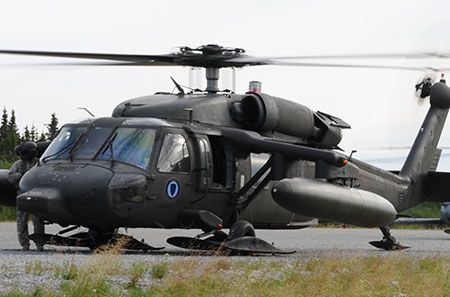Specialist Insights: Enhancing Performance in UH 60 Helicopter Procedures
Understanding the Mechanics and Design Behind Uh 60 Helicopters
The UH-60 helicopter, generally referred to as the Black Hawk, stands as a peak of modern-day rotorcraft innovation, personifying a mix of durable design and detailed technicians. From its beginning to its present models, the advancement of this aircraft showcases a blend of development and practicality. As we peel back the layers of the UH-60's layout, a world of detailed systems and precise design comes to light. Comprehending the mechanics and design behind this versatile airplane introduces a realm where accuracy fulfills power, and where each component plays a crucial function in achieving flight.
Background of UH-60 Helicopters
The history of UH-60 helicopters traces back to the late 1970s when the USA Military looked for a advanced and functional energy helicopter to replace its aging fleet. In response to this requirement, the Sikorsky Airplane Company established the UH-60 Black Hawk helicopter. Introduced in 1979, the UH-60 promptly came to be a staple in armed forces operations as a result of its impressive capacities.
The UH-60 was created to master a selection of objectives, including army transport, clinical discharge, electronic war, and special procedures. Its capability to adapt to various functions made it an important asset to the united state Army and various other military pressures all over the world
Over the years, the UH-60 system has undertaken a number of upgrades and variants to enhance its efficiency and equal progressing mission demands. These helicopters have seen considerable service in problems such as the Gulf War, Afghanistan, and Iraq, showcasing their dependability and versatility in diverse functional environments. The UH-60's rich background is a testament to its long-lasting heritage as a premier utility helicopter.

Engine and Power Equipments
Using advanced propulsion technology, UH-60 helicopters are outfitted with sophisticated engine and power systems to make sure ideal performance and integrity in a series of operational circumstances. The UH-60, frequently called the Black Hawk, is powered by 2 General Electric T700-GE-701D engines, each with the ability of providing up to 1,940 shaft horse power. These turboshaft engines offer the necessary thrust for the helicopter to bring out its goals efficiently, including army transportation, clinical evacuation, and fight support.

Rotor System and Aerodynamics
How do the blades system and the rules of aerodynamics of UH-60 helicopters contribute to their functional effectiveness and flight capabilities? The blades system of the UH-60 helicopter plays an important role in giving lift and propulsion. The UH-60 includes a four-bladed, completely articulated blades system that allows for high ability to move and stability throughout flight. This design makes it possible for the helicopter to carry out a wide array of objectives, from transportation and medical discharge to fight operations.
Aerodynamics likewise play a key function in the efficiency of UH-60 helicopters. The streamlined fuselage and rotor blade design lower drag, permitting the helicopter to attain higher rates and better gas performance. The wind resistant layout of the UH-60 also adds to its capacity to run in varied ecological conditions, consisting of hot temperatures and high elevations.
Avionics and Trip Control Systems

In its intricate coordination with the rotor system and aerodynamics of UH-60 helicopters, the avionics and flight control systems create a crucial network of technologies forming the airplane's functional capacities. In the UH-60, these systems include digital displays, communication radios, Discover More General practitioner navigation, weather radar, and auto-pilot systems.
The trip control systems of the UH-60 are in charge of translating the pilot's inputs into the suitable adjustments to the blades system, ensuring stable trip and maneuverability. These systems include hydraulic actuators, servos, and computer systems that function together to regulate the tail and main blades, along with other trip control surface areas. By precisely taking care of the helicopter's flight dynamics, these systems allow pilots to carry out a large range of missions, from transportation and search-and-rescue to deal with operations, with accuracy and self-confidence.
Function and Applications in Aviation
Avionics systems in UH-60 helicopters include a variety of electronic systems that aid in navigation, interaction, tracking, and managing various airplane functions. These systems consist of electronic display screens, auto-pilot systems, communication radios, GPS navigation equipment, and weather radar. In addition, these systems include safety and security attributes such as auto-pilot modes, terrain recognition alerting systems, and stability augmentation systems to enhance the total security and operational capabilities of the UH-60 helicopters in numerous objectives, including army transportation, medical discharge, search and rescue, and airborne firefighting.
Final Thought
Finally, the UH-60 helicopter is a versatile airplane with a rich background and advanced design. Its engine and power systems, rotor system, the rules of aerodynamics, avionics, and trip control systems all work together to make it a effective and trusted equipment. The UH-60's role Learn More and applications in air travel are substantial, ranging from armed forces procedures to look and rescue objectives. Its continued advancement and use show its relevance in the area of aviation (uh 60).
In its elaborate control with the rotor system and aerodynamics of UH-60 helicopters, the avionics and trip control systems create a critical network of technologies forming the airplane's functional capacities.The trip control systems of the UH-60 are responsible for equating the pilot's inputs into the ideal adjustments to the blades system, making certain steady flight and important site ability to move. Avionics systems in UH-60 helicopters include a variety of electronic systems that help in navigating, communication, tracking, and managing different aircraft functions. Additionally, these systems integrate safety features such as auto-pilot settings, surface recognition alerting systems, and stability enhancement systems to enhance the total safety and security and functional capacities of the UH-60 helicopters in various objectives, consisting of troop transportation, medical emptying, search and rescue, and aerial firefighting.
Its engine and power systems, rotor system, the rules of aerodynamics, avionics, and flight control systems all function together to make it a efficient and dependable equipment.